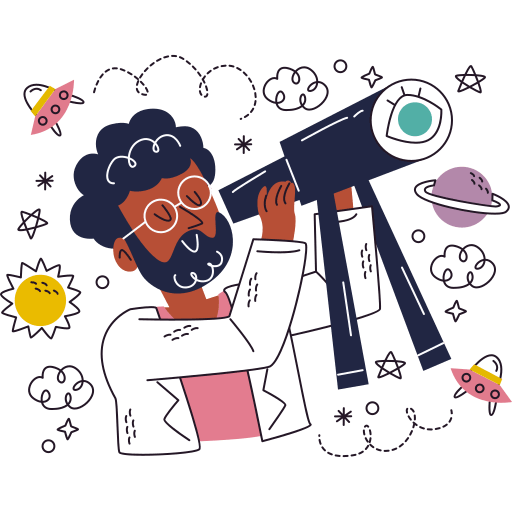Use Cases of Data Science in Astronomy, Fintech, Healthcare, Marketing, Transport, and Logistics.
Table of contents
A data science use case is a scenario in which data is used to answer a particular question or solve a specific problem.
These use cases can range from understanding customer behavior to predicting stock prices.
Data science use cases often involve collecting, analyzing, and visualizing data to make conclusions and decisions.
Astronomy:
Data science can be used in astronomy to analyze astronomical data, such as star locations, light intensities, star distances, and other data collected by telescopes or satellites.
This data can be analyzed to create models of the universe, such as star and galaxy formation and evolution, or to discover new exoplanets.
- Analyzing large astronomical datasets to identify new objects in space.
Using data science to predict the behavior of celestial bodies and to better understand their properties.
Using machine learning algorithms to detect subtle signals in noisy astronomical images.
1. Automation of Astronomical Data Analysis:
- Data science can be used to automate the analysis of astronomical data, including the detection of objects in images, the classification of stars and galaxies, and the detection of exoplanets.
2. Simulation of Astronomical Objects:
- Data science can be used to simulate the behavior of astronomical objects such as stars and galaxies, as well as the evolution of the universe over time.
3. Exploration of Exoplanet Characteristics:
- Data science can be used to explore the characteristics of exoplanets, such as their atmospheres, surface temperatures, and composition.
4. Identification of New Astronomical Phenomena:
- Data science can be used to identify new astronomical phenomena, such as supernovae, gamma-ray bursts, and gravitational waves.
5. Prediction of Stellar and Galactic Activity:
- Data science can be used to predict the activity of stars and galaxies, including their evolution over time.
Analyzing Wavelengths of Light:
Scientists use a spectrograph to analyze the light coming from any object in the universe.
Spectrograph breaks the light into its component colors (allows scientists to analyze wavelengths of light).
Scientists have data about the wavelengths. They know which particle is present in the wavelength if a certain amount of light is blocked.
It helps scientists discover life on other planets by studying atmospheric combinations of planets and other objects in the universe.
A similar example can be seen in a recent event when scientists discovered water in the wavelengths of light coming from an exoplanet known as WASP-96 b.
Data-Driven Space Exploration and Decisions:
Let's take the example of how NASA uses data science for data-driven space exploration and decision.
NASA receives a massive amount of data from satellites and other instruments in the universe daily.
To explore the universe using data collected by NASA.
The Data Science professionals of NASA help in everything from predicting weather on Earth to monitoring every object in the universe.
It helps better decision-making about the earth and everything in the universe.
Fintech:
Data science can be used in fintech to predict financial trends and markets, such as stock prices and currency exchange rates.
Data science algorithms can be used to analyze large amounts of financial data to identify patterns and correlations, which can then be used to predict future market trends and make better investment decisions.
Using machine learning algorithms to detect fraudulent transactions.
Using data science to develop customer segmentation and personalization strategies.
Using data science to predict customer behavior and improve customer engagement.
Froud Detection:
Data Science helps in the prevention of fraudulent transactions.
It is done by monitoring the historical transaction of the customer and identifying unusual transactions.
Fintech companies train machine learning models using the data about the previous transactions of their customers.
Their systems predict fraudulent transactions if the transactions are unusual according to the past transaction behavior of the customers.
Credit Allocation:
Whenever you apply for a loan, you only get a loan if your credit history calculates your credit score.
If your credit score is good enough according to the market, you will get a loan from the bank.
To process the task of credit allocation instantly, banks classify all the customers based on their credit history.
It enables banks to predict whether the customer is a good candidate for a loan and also helps in the fast approval of loans.
Predicting Transaction Volume:
A client's transaction volume is the total number of transactions processed in a period.
Fintech companies keep a record of all the transactions to predict the volume of transactions on their payment platforms.
It helps in recommending services according to the historical transactions of the customers and notifying them about their recurring bills and payments.
Automated Investing:
- Data science is being used to develop automated investment models that can analyze market conditions and customer preferences to make better investment decisions.
- This can help financial institutions provide their customers with more personalized and tailored investment advice.
Risk Management:
- Data science is being used to create predictive models that can identify and analyze patterns in financial data to identify potential risks.
- This can help financial institutions better manage their risk exposure and improve their overall risk-management strategies.
Financial Planning:
- Data science is being used to create financial planning tools that can analyze customer income, expenditure, and other financial data to help customers make better financial decisions.
- This can help financial institutions provide their customers with better financial advice and planning tools.
Marketing:
Marketing Data science can be used in marketing to analyze customer data, such as purchase and browsing habits, to better understand their needs and preferences.
This data can then be used to create targeted marketing campaigns and better understand customer segments.
Data science can also be used to optimize the customer experience, such as by creating personalized product recommendations or improving website design.
Utilizing predictive analytics to better target customers with personalized offers.
Using data science to optimize marketing campaigns for maximum profitability.
Using machine learning to analyze customer sentiment and optimize marketing messages.
Finding the Right Audience (FRA):
With the use of Data Science in marketing, ways to find the right audience have evolved rapidly.
Finding the right audience means finding and selecting the category of people who are most likely to buy the product or service.
If a brand promotes its product without targeting the audience, it will waste most of its marketing budget.
So, the ads you see on Meta and Youtube are examples of how businesses use Data Science to find the right audience to promote their products and services.
Customer Personality Analysis (CPA):
Today businesses use Facebook, Instagram, and YouTube to run ads to promote their products and services.
Once a brand determines its target audience, it is up to the personality and interests of all users to profitable customers the brand's target audience.
These platforms have a lot of data about their users. They know what their users like and what they pay the most for their attention to.
These companies create personality groups based on the interests of the users.
That helps in running ads among the most profitable customers.
Finding Content Creation Strategies:
Some of the businesses don't sell any products or services.
They create content and depend on the traffic they get from each piece of content they post.
In such cases, such businesses need to reach the most users daily.
The use of data science in content creation is to find the most engaging topics, the best time to post your content, the countries you get most of your traffic from, etc.
Even we use our data to make strategies for our Instagram community.
It helps to get more traffic and more users daily.
Predictive Modeling:
- Predictive modeling uses data science techniques to analyze customer data to predict future behavior.
- This can help marketers better target their campaigns and offers, as well as identify new market opportunities.
Customer Segmentation:
- Data science techniques can be used to group customers into distinct segments based on their behavior and preferences.
- This can help marketers tailor their campaigns to specific customer types and optimize their reach and impact.
Personalization:
- Data science can be used to create personalized experiences for customers based on their past behavior.
- This can help marketers serve more relevant and engaging content to the right customers at the right time.
Lead Scoring:
- Lead scoring uses data science to automatically rank leads based on their likelihood of becoming customers.
- This can help marketers prioritize and focus their efforts on the most promising leads.
Optimization:
- Data science can be used to optimize marketing campaigns and processes by testing different variables and identifying the most effective combinations.
- This can help marketers get the most out of their efforts by delivering the highest ROI.
Healthcare:

Patient Risk Stratification:
- Leveraging predictive analytics to identify patients who are at risk of developing chronic diseases.
Disease Prediction:
- Using machine learning algorithms to predict the probability of a patient developing a particular disease based on their medical history and lifestyle.
Clinical Trial Optimization:
- Using predictive analytics to identify the best candidate for a clinical trial based on the patient's medical history and other data points.
Clinical Decision Support:
- Utilizing artificial intelligence to provide clinicians with evidence-based guidance to make decisions for their patients.
Healthcare Fraud Detection:
- Using data analysis to detect fraudulent activities in healthcare.
Drug Discovery and Development:
- Leveraging data science to identify new drug targets and develop better drugs with fewer side effects.
Electronic Health Records Management:
- Utilizing data science to improve the management of health records and ensure patient data is secure.
Population Health Management:
- Using data analysis to identify population health trends and develop programs to address them.
Personalized Medicine:
- Utilizing data science to create personalized treatment plans for individual patients.
Remote Patient Monitoring:
- Using sensors and data analysis to monitor.
Transport and Logistics:
In the logistics industry, data science is being used to optimize the entire supply chain process. This includes the use of data to predict demand, plan inventory, determine optimal shipping routes, and predict customer behavior.
Additionally, data science can be used to monitor and ensure quality control, reduce costs, and improve customer satisfaction.
Data science can also be used to create predictive models to anticipate customer needs and identify potential opportunities for improvement.

Predictive Maintenance:
Predictive maintenance uses data science to analyze historical usage and sensor data to determine when specific transport and logistics assets will need maintenance.
This allows companies to reduce maintenance costs and improve operational efficiency.
Automated Route Optimization:
Automated route optimization uses data science algorithms to optimize transport and logistics routes for maximum efficiency and fuel savings.
This helps companies save time and money on their daily operations.
Inventory Management:
Data science algorithms can be used to analyze historical data and customer demand to optimize inventory levels and ensure that the right products are available when customers need them.
This improves customer satisfaction and reduces costs associated with overstocking or understocking.
Demand Forecasting:
Demand forecasting uses data science algorithms to analyze historical data and customer demand patterns to predict future demand for transportation and logistics services.
This helps companies better prepare for future demand and optimize their resources and operations.
Autonomous Vehicles:
Autonomous vehicles use data science algorithms to make decisions in real-time and navigate complex environments.
This technology is becoming increasingly important in the transport and logistics industry as it can reduce costs, improve safety, and reduce emissions.
Real-Time Tracking:
- Implementing AI-based tracking systems to monitor and report on the location and status of vehicles in transit.
Supply Chain Optimization:
- Leveraging data science to analyze customer demand and optimize the entire supply chain process.
Automated Fleet Management:
- Using machine learning algorithms to analyze and predict vehicle performance, route optimization, and fuel consumption.


